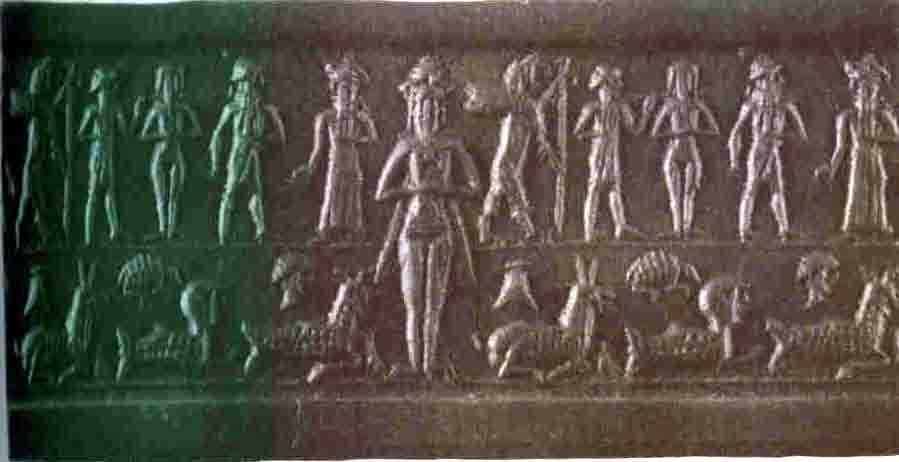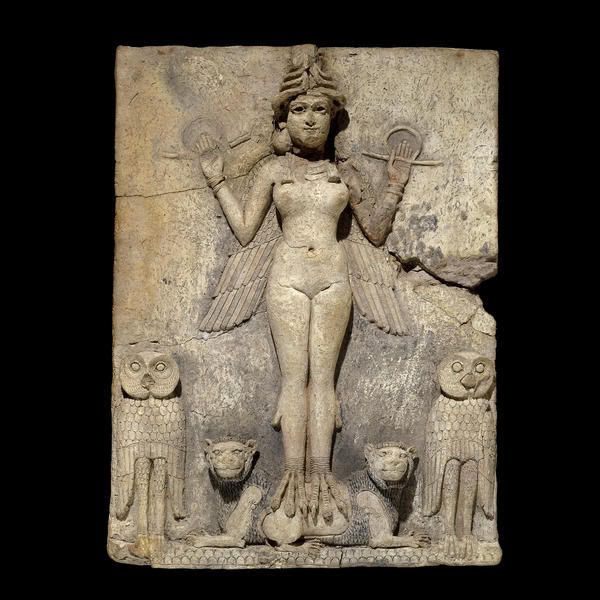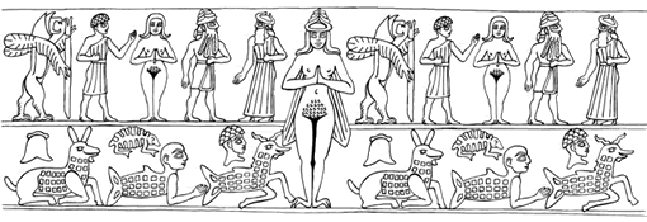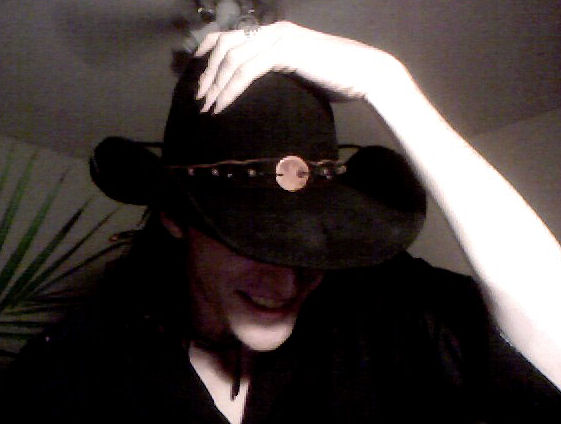|
|
Post by xuchilpaba on Feb 28, 2008 17:57:03 GMT -5
I think I have uncovered the identity of the figure on the old Babylonian relief known by its former owners name "the Burney relief". Older scholarship said this was Lilith, mainly because of bird feet & Kramer's translation of Kiskilillake. However, even then it proved controversial as some scholars couldn't understand why a minor demoness such as Lilitu would be depicted in such a manner and perserved, they named it Inanna. Popularly this relief has been adopted by Neopagans, ignoring modern schoalrship they still cling to the idea that they are 100% positive its Lilith and could never be Inanna. (With their little knowledge of Sumer, because they don't care about the rest of Sumer or its religion, just Lilith.) Modern scholarship favors Inanna or Ereshkigal, mostly Inanna. Looking in the Inanna, Queen of Heaven and Earth: Her Stories and Hymns from Sumer, while browsing through notes, I cam across a tid bit that went something like this: "She may depict the chthonic aspect of Inanna from the association with the various demonic bird-like creatures and gods that inhabit the underworld. The goddess’s horned head would appear alongside other deities and human worshippers, while the bird feet appear beside demonic creatures. The hierarchical arrangement of the scene would indicate Inanna’s dual nature; that of “heaven and earth” and that of the underworld." So I flipped to the page this note was referring to, as it could not be the Burney relief... Shockingly i discovered this:  Or:  I have a bad close up shot of it too:  There is now no doubt that the Burney relief is Inanna. Burney relief:  Shes nude, displays the same turban, same bird feet, same downed wings, and a similar pose. Theres now no doubt in my mind now... the Burney relief is Inanna! Ths underworld relief has never showed up online, nor is it ever referred to as "Lilith" (Pfft, yeah especially w/ human worshippers at the feet.) but scholar believe this to be conclusively Inanna. SO whats with this big fuck up with the Burney relief? I don't know as much about ther Sumerians as alot of you do and I can positiviely identify that relief! ALL I could think of is the scholars and Neopagans who have clinged to the idea that this is Lilith despite evidence. |
|
|
|
Post by madness on Feb 29, 2008 1:43:05 GMT -5
Thorkild Jacobson reached the conclusion that the burney relief represents Inanna/Istar in 1987 (see "Pictures and Pictorial Language (The Burney Relief)," in M. Mindlin et al. (eds.), Figurative Language in the Ancient Near East), and scholars have accepted this since. I don't know of any scholars that still equate the relief with Lilith...
|
|
|
|
Post by xuchilpaba on Feb 29, 2008 16:40:55 GMT -5
Hurwitz still did. Most that I ran across that still believe this is Lilith are Neopagans that push their opinions. Whats worse is that a majority of those pushers' knowledge of Mesopotamia is almost non-existent. If they looked at facts, like that not many reliefs of demons survive because of the ritual of destroying the image and other reliefs of Lili depict her malvolently and doing things like devouring children, they might figure out that the real Lilith is alot more malevolent and not even close to Inanna on the Burney relief...
|
|
|
|
Post by xuchilpaba on Mar 16, 2008 18:08:13 GMT -5
Clearer image:  Compare to the:  As you can see, it appears to be the same goddess. |
|
|
|
Post by us4-he2-gal2 on Jul 21, 2008 15:54:44 GMT -5
Very nice little insight on this thread, and the idea of Inanna as a simultaneous member of more than one domain works quite well with material I have just posted on the
Inanna/Ishtar/Aphrodite/Isis thread - note also Lapinkivi's description of Inanna as mediator between heaven and the netherworld (Vampire thread, reply # 17 - Madness). I see you have already referred to Jacobsen's finding on the Burney relief Madness, erudite fellow you. But I post Harris's recounting of that finding for more description, "Relevant here is the new interpretation by Thorkild Jacobsen of the well-known Burney Relief. [referring to Jacobsen "Pictures and Pictorial Language (The Burney Relief) from Figurative Language of the Ancient Near East 1987]. The winged goddess of the plaque with bird's claws, flanked by owls and standing on two lions couchant, he believes, is Inanna as "Lady Owl" who, when named Kilili, "denotes the harlot who like the owl comes out at dusk.: He suggests that the Burney Relief may have "served as a cult-relief at the house alter of an ancient bordello." If so, and Jacobsen makes a convincing case, then the very depiction of the goddess breaks down the boundary between species, between the divine and ornithic." |
|
|
|
Post by madness on Nov 11, 2008 1:14:56 GMT -5
Summary as Jacobsen puts it in Figurative Language (p. 6):
1. The size of the relief suggests a cult-relief. Since demons had no cult the figure depicted is unlikely to be a demon.
2. The horned crown with four tiers suggests a major deity.
3. The lions suggest Inanna, since she is the only goddess associated with lions
4. The mountain pattern fits since Inanna's home was the mountain crests in the east.
5. The yardstick and coil of rope in her hands accord with the description of her in the myth Inanna's Descent.
6. So does the necklace she is wearing.
7. Finally, the owls and the wings and bird talons of the figure show that Inanna is pictured in her aspect of Owl-goddess and goddess of harlots, Ninnina, in Akkadian Kilili.
One may therefore hazard the opinion that the Burney Relief represents Inanna as a goddess of harlots and served as a cult-relief at the house-altar of an ancient bordello. If so, that would explain also a last unusual feature of the relief, the nudity of the figure. Nudity is practically never found in monumental art in Ancient Mesopotamia and seems to have been deliberately avoided for reasons of propriety. In a bordello, though, it would hardly give offence.
|
|
|
|
Post by xuchilpaba on Nov 15, 2008 17:46:23 GMT -5
^great info.
I always point out that demon images are rare from Mesopotamia, because of the ritual of destroying them. The one we have of Lamastu was out of pure luck that it even existed. I would also question why Lilith would be depicted in a benevolent manner? Every image I saw that survived of demons, including Lilitu's Aslan Tarsh amulet shows them in monstrous often ferocious forms. Lili is seen depicted in that amulet devouring a child. The Babylonian incantation bowls also paint a horrific picture of her.
I think the Lilith thing should pretty much go away. (Technically the owls are "Liliths". I am not sure why the demon Lilith herself would be depicted with them, because of the confusion.) Hopefully good scholarship can over come the popular Neopagan conception.
|
|
|
|
Post by xuchilpaba on Nov 17, 2008 9:30:55 GMT -5
Was Inanna connected to owls before Lilith came about?
|
|
|
|
Post by sheshki on Dec 9, 2008 18:44:56 GMT -5
At the website of British Museum is a reconstruction of the original painting of the burney relief. www.britishmuseum.org/explore/world_cultures.aspxBtw, you can register free there and receive hi-res images of the exhibition pieces.Up to 100 per month, for private or research use only.  |
|
|
|
Post by sheshki on Dec 11, 2008 19:59:32 GMT -5
I tried out the free picture service of the british museum and received some nice hi-res images. |
|
|
|
Post by xuchilpaba on Dec 15, 2008 15:01:45 GMT -5
I can't believe I totally forgot to post that pic! i just stole it off their website.
They have some nice Mesoamerican things, I might register for that.
(Before I saw the reproduction picture... I didn't know she had a unibrow. Was this common in Mesopotamia?)
|
|
|
|
Post by scribeofnisaba on Jan 22, 2009 14:01:19 GMT -5
Eleanor Robson has written a splendid article called "Gendered literacy and numeracy in the Sumerian literary corpus" which touches on the Burney Relief (identifying it with Inana) in which she presents pretty much irrefutable evidence that the goddess depicted is Inana, probably on the way down to the Netherworld (as in Inana's Descent). The article is a cracking good read and I'd recommend it to anyone with an interest in goddesses and their representation in both literature and art. It's published in "Analysing Literary Sumerian - corpus-based approaches" eds. Jarle Ebeling and Graham Cunningham.
And yes, the monobrow was a sign of beauty in Mesopotamia. Funny how times change!
|
|
adante
dubĝal (scribes assistent)
 
Posts: 41
|
Post by adante on Jan 22, 2009 15:17:40 GMT -5
Ok this is me in dumb mode, brought on by extreme tiredness. I went to the link for the British museum, but couldn't see where to sign up for the pics. Did I miss something?
|
|
|
|
Post by sheshki on Jan 22, 2009 18:05:13 GMT -5
Klick the link, go to a culture ur interested in. Then click on the first related object. On the next page click "use digital image" and you get forwared to a sign up page.
|
|
adante
dubĝal (scribes assistent)
 
Posts: 41
|
Post by adante on Jan 23, 2009 19:18:22 GMT -5
Sheshki, yet again thank you  |
|
|
|
Post by xuchilpaba on Jan 23, 2009 19:58:24 GMT -5
But I'm curious to why the connection between the winged figure in the initial post is quickly connected to the Burney relief...my experience has been there is at least one other god with that sort of design of the wings folded down - pazuzu...I have no idea of the scholar work on the god so bear that in mind. Aside from the wings I see no other similarity. It's clearly a female, complete with pubic hair:  Pazuzu is more of a monster looking entity that has a scorpion tail penis. |
|
|
|
Post by xuchilpaba on Jan 26, 2009 3:24:13 GMT -5
The original was posted twice at the top of the thread. It was tied and identified as the figure on the Burney relief in the book Inanna:Queen of heaven and earth by Kramer
|
|
|
|
Post by xuchilpaba on Jan 31, 2009 12:51:25 GMT -5
theres some similar reliefs that are of Asherah or Qadesh i believe and of Anath. I don't have the pictures off hand but i can see if i can dig some up for comparison when i'm not at work.  |
|
|
|
Post by sheshki on Feb 4, 2009 21:50:15 GMT -5
In a documentary about mesopotamia (Es war einmal in Mesopotamien" produced by arte tv) i found a nice picture of a relief of a winged goddess, maybe Inanna.  |
|
|
|
Post by xuchilpaba on Feb 7, 2009 22:05:17 GMT -5
do you know the name of this relief? I want to look up the research on it. I love this picture!
|
|
|
|
Post by madness on Feb 7, 2009 23:52:09 GMT -5
It is an (impression of) Old Babylonian mould now in the British Museum, identified by Julian Reade* as the "exhibitionist Ishtar." Reade briefly compares it to the Burney Relief, with our mould having wings and clawed feet.
* "Sexism and Homotheism in Ancient Iraq," in S. Parpola and R.M. Whiting (eds.), Sex and Gender in the Ancient Near East
|
|
|
|
Post by xuchilpaba on Feb 10, 2009 8:51:05 GMT -5
There's a 3rd piece from Louvre of the same relief that i believe was found in a burial tomb. The site i usually have as reference though is sadly down right now.
|
|
|
|
Post by madness on Mar 15, 2009 23:49:34 GMT -5
img25.imageshack.us/my.php?image=10471114.jpgCheck out this image that appears on a boundary stone ( kudurru), showing a winged goddess, with snake-like entwined legs, and who is naked, I assume, due to the prominent pubic triangle. Possibly related, in spirit, to the Burney Relief? The goddess on the stone demonstrates a similar - upper body divine, lower body chthonic - idea, so I speculate that she is Ištar, also notice the eight pointed star to the upper right of the image. On the other sides of the same stone there is a centaur and a satyr, reinforcing the half-human half-animal theme. On top of the stone is a coiled snake. Text and plates (thanks to sheshki for pointing these out) can be downloaded here. See text pages 19-23 and plates 23-30 for this stone. www.etana.org/abzu/coretext.pl?RC=20257www.etana.org/abzu/coretext.pl?RC=20238
|
|
|
|
Post by xuchilpaba on Jun 7, 2009 19:44:39 GMT -5
Vase depicting Ishtar in the Louvre Museum. "This large ritual container was found in a tomb in the city of Larsa in southern Mesopotamia. It is decorated with the image of Ishtar, the great goddess of fertility. She is shown here as the mistress of animals, and is surrounded by birds, fish, a bull and a tortoise, all expressions of various sorts of natural fertility. The goddess is depicted frontally, wearing a horned tiara, the symbol of divinity. Arms opened wide, she displays her nudity as the divine incarnation of Love and the mistress of sexuality and fertility. Her wings symbolize her astral dimension, where she is identified with the planet Venus. Although Ishtar is the goddess of love and female sexuality, she is just as frequently depicted as a warrior, leading armies into combat and deciding the outcome of battles. She thus incarnates, in a single personality, the indivisible forces that rule over life and death." 
|
|
|
|
Post by muska on Mar 7, 2011 11:54:35 GMT -5
There were some Ishtar-like goddesses - Nanaya, Anunitum, Beltu-sha-resh, Hurrian deity Shavushka and so on. So in most cases we can't precisely tell, whether female deity represented on a relief or on seal is Inanna-Ishtar or any other goddess. A unique exception is head of Inanna from Uruk because no goddess except Inanna in the main temple of this city could be: commons.wikimedia.org/wiki/File:UrukHead.jpgIf the kudurru image mentioned by Madness is indeed Ishtar it will be very nice connection with some moments in texts and earlier iconography related to her cult, but I think we will be careful with interpretations (it also regards the images of other gods). |
|
|
|
Post by sheshki on Mar 7, 2011 17:00:04 GMT -5
|
|
|
|
Post by muska on Mar 8, 2011 5:57:40 GMT -5
Thank you, Sheshki, for posting this image - it is a wonderful expression of Inanna s character.
|
|
























